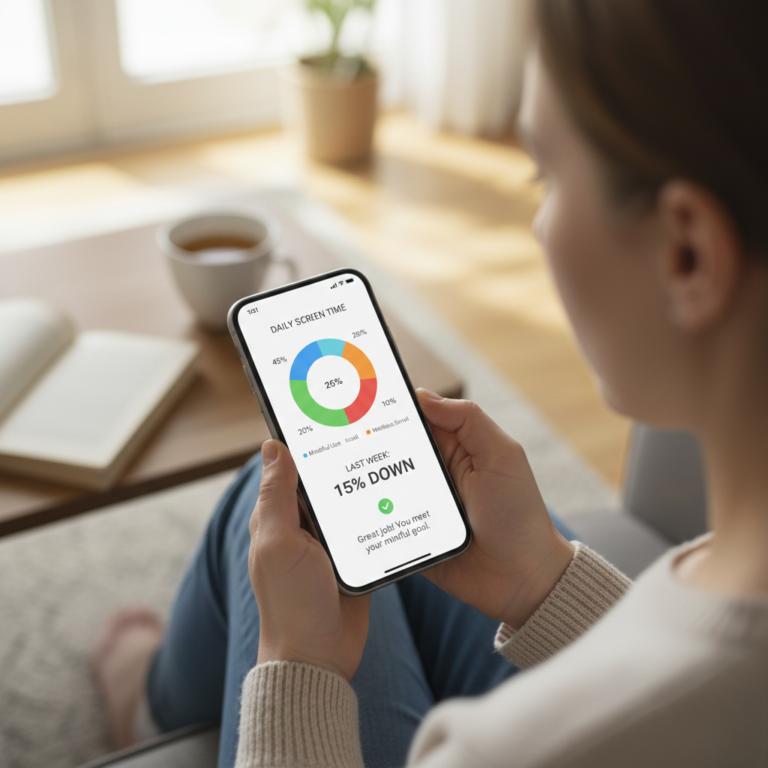
You’ve got productivity apps on every device, digital calendars synced across platforms, and task management software with endless features—yet somehow, you feel less focused and more overwhelmed than ever. If this resonates, you’re part of a growing movement of leaders questioning whether digital tools are truly serving their productivity needs. Escape the digital clutter and rediscover focus through the Analog Productivity Revolution.
The statistics tell a compelling story: while productivity software spending has increased by 42% over the last five years, actual workplace productivity has improved by just 8%. Meanwhile, sales of physical planners and notebooks have surged by 65% since 2019, with executives and leaders driving this resurgence.
Perhaps most telling, a recent Harvard Business Review survey found that 76% of C-suite executives report using paper planners or notebooks alongside their digital tools.
As a productivity consultant who has worked with executives across industries, I’ve witnessed this analog renaissance firsthand. One Fortune 500 CEO I advised reduced her meeting time by 35% after transitioning key planning processes from digital to paper. Another client—a tech startup founder ironically enough—reported that his team’s strategic thinking improved substantially after implementing analog brainstorming sessions.
In this comprehensive guide, you’ll discover:
- The cognitive science behind why analog tools enhance focus, creativity, and retention
- The surprising productivity costs of our digital dependency
- A practical 30-day blueprint to integrate paper-based systems into your workflow
- 50 powerful analog productivity techniques used by successful leaders
- Strategies to create an optimal hybrid approach combining digital efficiency with analog effectiveness
By the end of this journey, you won’t just understand why leaders are returning to paper—you’ll have concrete tools to transform your own productivity approach and reclaim the clarity that digital overwhelm has eroded.

Understanding the Analog Productivity Renaissance
The return to paper isn’t mere nostalgia—it reflects fundamental cognitive and psychological benefits that digital tools often undermine.
When productivity software first revolutionized the workplace, the promise was clear: automation would handle mundane tasks, digital platforms would streamline collaboration, and our mental bandwidth would be liberated for higher-value thinking.
Yet decades into this digital experiment, many leaders find themselves trapped in what productivity researcher Cal Newport calls “the hyperactive hive mind”—a state of perpetual responsiveness that fragments attention and prevents deep work.
Research from neuroscience offers compelling explanations for why analog tools counteract these effects. Studies from the University of Tokyo reveal that writing by hand stimulates areas of the brain associated with learning and memory in ways typing cannot replicate.
Meanwhile, work from Princeton University demonstrates that students who take notes by hand exhibit substantially better conceptual understanding and retention than those using laptops—even when the digital note-takers are instructed not to transcribe verbatim.
What makes analog tools particularly powerful for productivity is how they engage our brains differently:
| Analog Advantage | Cognitive Impact |
| Physical writing activates motor memory | Enhanced retention and integration of information |
| Limited space creates natural constraints | Forces prioritization and synthesis |
| Absence of notifications and updates | Facilitates sustained attention and flow states |
| Tactile engagement with materials | Increases present-moment awareness |
| Visual-spatial arrangement on paper | Strengthens conceptual connections and creativity |
Why is this shift happening now? After years of digital acceleration, we’ve reached what psychologist David Levy calls “information metabolism overload”—our cognitive systems simply cannot process the volume and velocity of digital inputs we face daily.
The average knowledge worker now switches tasks every 3 minutes, checks email 74 times daily, and receives 46 smartphone notifications per day. Against this backdrop, analog tools provide a form of resistance: they create what design ethicist Tristan Harris calls “beneficial friction” that slows us down in precisely the ways our brains need.
By understanding these dynamics, we can approach analog productivity not as a rejection of technology, but as a deliberate recalibration of our relationship with tools that shape our thinking.
10 Warning Signs of Digital Productivity Overload
Recognizing when digital tools are hindering rather than helping is essential for recalibrating your approach. If these signals sound familiar, analog methods might offer valuable balance:
- You frequently feel busy yet unproductive – Completing numerous tasks while making minimal progress on meaningful work
- You struggle to recall meeting details without referencing notes – Digital note-taking failing to create memorable mental impressions
- Your to-do list has become unmanageably long – Digital tools enabling endless task accumulation without natural constraints
- You experience difficulty maintaining focus during planning sessions – Digital environments creating constant temptation for task-switching
- Your creative thinking feels constrained or formulaic – Digital templates limiting unconventional approaches or insights
- You notice decreasing retention of information you process – Skimming rather than deeply engaging with content
- You feel tethered to devices for basic organizational functions – Growing dependency on digital tools for tasks once handled independently
- Your thinking has become increasingly reactive rather than proactive – Responding to notifications rather than following intentional priorities
- You experience satisfaction primarily from completing small tasks – Digital tools encouraging low-value “productivity theater”
- You find yourself regularly overwhelmed by your organizational systems – Complexity of digital productivity infrastructure creating additional cognitive burden
How many of these warning signs do you recognize in your own work patterns? If three or more resonate with your experience, integrating analog productivity methods could significantly enhance your effectiveness and wellbeing.
Preparing for Your Analog Productivity Integration
Successfully incorporating analog methods requires thoughtful preparation rather than simply purchasing a planner. This foundation will enable you to create a sustainable system that complements rather than conflicts with necessary digital tools.
Clarifying Your Productivity Pain Points
Begin by identifying precisely where digital approaches are failing you. Research from the Productivity Institute shows that targeted interventions addressing specific workflow challenges yield 3.4x greater improvement than general productivity overhauls.
Document your current challenges across key dimensions:
- Which types of thinking or planning feel most fragmented?
- When do you experience the greatest difficulty maintaining focus?
- Which work outputs would benefit most from deeper processing?
- Where do you feel most dependent on technology yet least satisfied with results?
“Understanding exactly where digital systems underperform for your specific cognitive style is essential,” explains productivity researcher Dr. Sophie Leroy. “Analog tools aren’t universally superior—their benefits emerge when strategically deployed to address specific thinking needs.”
Selecting the Right Analog Tools
The effectiveness of analog productivity hinges on choosing tools matched to your specific requirements. Consider these key factors:
- Portability needs – How frequently will you need your system available across locations?
- Structure preference – Do you benefit from pre-formatted layouts or prefer blank canvases?
- Time orientation – Is your work primarily calendar-driven or project-focused?
- Revision patterns – How often do your plans change, requiring flexibility in your system?
- Integration requirements – Which digital systems must remain connected to your workflow?
- Aesthetic sensitivity – How much does the physical appeal of tools affect your engagement?
Research from the Journal of Consumer Psychology demonstrates that physical tool satisfaction significantly impacts consistency of use—productivity tools that provide tactile and visual pleasure show 58% higher adoption rates.
Creating Your Hybrid Workflow Foundation
Before implementing analog methods, establish clear principles for your hybrid system:
- Determine decision rights – Which system (digital or analog) will be authoritative for different information types?
- Establish migration protocols – How will information move between systems when necessary?
- Define boundary rituals – What practices will help you transition between analog and digital modes?
- Create redundancy rules – Which information requires backup across systems?
- Develop maintenance schedules – When will you update and align your various tools?
“The most successful productivity systems acknowledge that neither all-digital nor all-analog approaches are ideal for most knowledge workers,” notes productivity author Tiago Forte. “The key is designing intentional interfaces between methods.”
By thoughtfully preparing your approach, you’re not just adopting tools—you’re designing an ecosystem that enhances your cognitive strengths while mitigating your vulnerabilities.
The 30-Day Analog Productivity Blueprint
Meaningful shifts in productivity habits require structured implementation and experimentation. This 30-day progression guides you through a sustainable transition to an analog-enhanced workflow.
Week 1: Analog Foundations (Days 1-7)
Objective: Establish basic analog practices and observe their immediate impact
Actions:
- Purchase a high-quality notebook and pen that you genuinely enjoy using
- Begin each day with a 10-minute handwritten planning session
- Conduct one meeting daily using only paper notes
- Create a physical “waiting for” list tracking delegated items
- Each evening, handwrite your three priorities for the following day
- Experiment with analog time blocking for at least two hours daily
- Begin a “decision journal” documenting key choices and their context
What to expect: Many leaders experience initial resistance followed by surprising relief. Research from the Psychology of Well-being Journal indicates that analog planning reduces anticipatory anxiety by 37% compared to digital methods, with effects typically noticeable within 3-5 days.
Week 2: Strategic Analog Integration (Days 8-14)
Objective: Expand analog methods to higher-cognitive activities and create sustainable systems
Actions:
- Implement a paper project planning template for one significant initiative
- Conduct a full weekly review using a physical planner or notebook
- Try handwritten mind mapping for a complex problem or opportunity
- Designate one “device-free” planning block of at least 90 minutes
- Experiment with Cornell note-taking method for an important meeting
- Create a physical dashboard tracking key metrics or habits
- Begin using handwritten agendas for meetings you lead
What to expect: As analog methods expand, you’ll likely notice improved retention of information and enhanced clarity around priorities. Some digital withdrawal symptoms may emerge as dependencies are challenged.
Week 3: Analog Thinking Enhancement (Days 15-21)
Objective: Leverage analog methods for deeper thinking and creative problem-solving
Actions:
- Conduct a “paper sprint” for generating ideas around a key challenge
- Create a physical decision matrix for an important choice
- Implement a handwritten reflection protocol at day’s end
- Try sketchnoting (visual note-taking) for a complex topic
- Develop a paper-based personal kanban system for workflow visualization
- Write a long-form analysis of a business challenge without digital reference
- Use the “second brain” method for a physical knowledge management system
What to expect: Week three typically reveals analog’s distinct advantages for certain cognitive processes. Many leaders report breakthrough insights during this phase as thinking patterns shift from fragmented to integrated.
Week 4: Sustainable Hybrid Optimization (Days 22-30)
Objective: Refine your personalized blend of analog and digital methods for long-term success
Actions:
- Document your emerging analog-digital system architecture
- Create dedicated physical storage and organizational systems
- Establish triggers for when to use analog versus digital approaches
- Develop protocols for transferring necessary information between systems
- Schedule regular maintenance sessions for your analog tools
- Design accountability measures to maintain analog practices
- Conduct a comprehensive review identifying which analog methods provided greatest value
What to expect: By day 30, most leaders have identified a personalized “productivity stack” combining analog and digital methods optimized for their specific cognitive style and work demands.
50 Powerful Analog Productivity Techniques
The most effective analog productivity approach draws from diverse techniques aligned with specific thinking needs. These methods are organized by the core cognitive functions they enhance:
For Focus and Clarity
- The Ivy Lee Method: Handwrite six priorities each evening in order of importance
- Time blocking with a paper planner using timeboxing techniques
- The “Most Important Task” (MIT) index card method
- Single-tasking with a physical timer for Pomodoro sessions
- Analog kanban boards with sticky notes for workflow visualization
- “Commitment inventory” for physically documenting promises made
- Daily highlight journaling for capturing key outputs and insights
- Paper-based “capture cards” for collecting thoughts without disruption
- Decision journals documenting major choices and their rationale
- Physical “don’t do” lists identifying deliberate exclusions
For Strategic Thinking
- Mind mapping complex issues with pen and large paper
- Scenario planning with a quadrant diagram
- The “Five Whys” exercise on paper for root cause analysis
- Eisenhower Matrix drawn for decision prioritization
- SWOT analysis using color-coded sticky notes
- Stakeholder mapping on paper for relationship visualization
- Challenge assumption exercises with handwritten statements
- Future backwards planning starting from desired outcome
- Analog PEST analysis for environmental factor consideration
- “Pre-mortem” journaling imagining project failure causes
For Creativity and Innovation
- Freewriting for 15 minutes without digital distractions
- Sketchnoting combining words and simple visuals
- Concept mapping with colored pens showing relationships
- The “crazy eights” rapid ideation technique on folded paper
- Forced connection exercises linking unrelated concepts
- Constraint-based creativity using limited space or materials
- Inspiration boards with physical images and quotes
- “Idea parking lots” in notebooks for capturing tangential thoughts
- Visual prototyping with simple drawings
- Analog mood boards for project aesthetic development
For Learning and Retention
- Cornell note-taking method dividing page into sections
- Handwritten book summaries after reading
- Concept flashcards for spaced repetition review
- Teaching sheets summarizing ideas as if explaining to others
- Verbal processing paired with handwritten documentation
- “Connection journals” linking new information to existing knowledge
- Learning logs tracking questions and insights
- Physical annotation systems for books and articles
- Knowledge trees mapping hierarchical information
- Retrieval practice journals for self-testing
For Wellbeing and Perspective
- Gratitude journaling with pen and paper
- Analog habit tracking with visual progress indicators
- Values alignment exercises in physical form
- Worry logs externalizing concerns onto paper
- “Done lists” celebrating daily accomplishments
- Handwritten personal mission statements
- Reflection rituals using journaling prompts
- Energy mapping throughout day in a physical log
- Boundary-setting documentation with specific triggers
- Legacy planning exercises on archival paper
The most effective approach is identifying which thinking challenges you face most frequently, then selecting analog techniques specifically designed to address them.
“The power of analog productivity isn’t in adopting every technique, but in selectively implementing methods that address your specific cognitive bottlenecks,” explains David Allen, productivity expert and creator of Getting Things Done. “Start with your biggest pain points and expand methodically.”
Creating a Sustainable Analog-Digital Hybrid System
The goal isn’t eliminating digital tools but creating an integrated system that leverages the strengths of both approaches. After your 30-day immersion, here’s how to develop a sustainable hybrid productivity ecosystem:
The Analog-Digital Decision Framework
Different cognitive tasks benefit from different mediums. Research from the Journal of Applied Psychology suggests these optimal allocations:
| Best for Analog | Best for Digital |
| Initial idea generation | Information storage and retrieval |
| Complex problem definition | Repetitive task management |
| Strategic planning | Calendar scheduling and reminders |
| Personal reflection | Collaborative document editing |
| Focused prioritization | Communication management |
| Creativity and divergent thinking | Data analysis and computation |
“Think of analog and digital tools not as competitors but as specialized instruments in your productivity orchestra,” suggests organizational psychologist Adam Grant. “The key is deploying each where it creates distinctive value rather than defaulting to one approach for all tasks.”
Core Principles for Hybrid Integration
Implement these foundational practices to maintain a cohesive system:
- Single source of truth – Designate one system (typically digital) as authoritative for commitments and deadlines
- Cognitive mode matching – Select tools based on the type of thinking required, not habit
- Friction by design – Intentionally create barriers around digital distractions
- Boundary rituals – Develop practices that signal transitions between analog and digital modes
- System reviews – Schedule regular maintenance of both analog and digital components
“The most productive leaders I’ve worked with are bilingual—fluent in both analog and digital methods, and discerning about when to use each,” notes productivity coach Laura Stack. “Their competitive advantage comes not from technology adoption but from tool discernment.”
Role-Modeling Analog Leadership
Your relationship with productivity tools shapes organizational culture more powerfully than any policy. Whether you lead a team, a company, or simply your own work, how you engage with analog methods sends strong signals.
For Organizational Leaders
Teams unconsciously mirror leadership behaviors around tool usage and attention management. Research from MIT’s Sloan School of Management demonstrates that leader tool preferences cascade through organizations, with 72% of team members eventually adopting similar approaches.
Effective analog leadership includes:
- Visibly using paper notebooks during meetings
- Creating handwritten notes of appreciation
- Designating device-free discussion periods
- Implementing analog facilitation for strategic sessions
- Discussing openly your productivity experiments and learnings
- Creating physical artifacts for important strategic frameworks
- Acknowledging both analog and digital preferences among team members
For Individual Contributors
Even without formal authority, your tool choices influence colleagues through what researchers call “permission-giving behaviors.”
Impactful approaches include:
- Bringing analog tools to digital-default environments
- Explaining the specific benefits you’ve experienced from analog methods
- Creating handwritten summaries of digital meetings
- Using paper tools without apology or excess explanation
- Suggesting analog experiments for team problem-solving
- Respecting others’ tool preferences while maintaining your own
“The most powerful statement about productivity is not what you say, but what you use when facing your most significant challenges,” explains productivity researcher James Clear. “Tools signal priorities and values.”
Troubleshooting Common Analog Integration Challenges
Even with thoughtful implementation, obstacles will emerge when establishing an analog productivity practice. Here’s how to address the most common challenges:
“I can’t efficiently share my handwritten notes with others.”
Solution: Adopt a selective digitization approach. Not everything requires sharing, but for content that does, use document scanning apps to create digital versions of key notes. Establish personal guidelines about which content merits digitization, and batch this process to prevent it from becoming a friction point. Some leaders use a “public/private” notation system, marking in the moment which notes will need digital conversion.
“I find myself duplicating information across systems.”
Solution: Implement the “write once, refer often” principle. Distinguish between reference materials (archive once, access repeatedly) and action items (require ongoing visibility). For reference materials, document once in your preferred medium, then simply note the location in other systems rather than duplicating content. For action items, select one authoritative system, typically digital for shared commitments and analog for personal priorities.
“My colleagues are fully digital and resist analog approaches.”
Solution: Frame analog tools as complementary rather than competitive with existing systems. Demonstrate specific use cases where analog methods enhance rather than replace digital workflows—strategic thinking sessions, focused planning blocks, or creative ideation. Rather than advocating system-wide changes, position analog methods as specialized instruments for high-value cognitive tasks. Share specific results rather than philosophical arguments.
“I’m struggling to maintain consistency with paper tools.”
Solution: Apply habit stacking by connecting analog practices to existing routines. Research from behavior design expert BJ Fogg shows that consistency improves by up to 80% when new practices are linked to established habits. Create environmental triggers by positioning analog tools at points of natural engagement—notebooks by morning coffee, planning templates on your desk at day’s end. Additionally, reduce initial scope by starting with just one analog practice performed daily rather than attempting a comprehensive system transition.
When to Seek Additional Resources
If you experience:
- Persistent productivity anxiety despite system experiments
- Difficulty maintaining focus even with analog methods
- Overwhelming information management challenges
- Teams resistant to necessary analog-digital integration
Consider specialized support through productivity coaching, organizational psychology resources, or communities of practice focused on knowledge work optimization. The Productivity Institute and the Digital Wellness Institute offer evidence-based programs specifically addressing hybrid productivity approaches.
Reclaiming Intentional Leadership Through Analog Methods
The analog productivity revolution isn’t about nostalgia—it’s about neural optimization. As we’ve explored throughout this guide, the resurgence of paper planners, notebooks, and physical thinking tools among leaders reflects a growing recognition that our most valuable thinking requires environments matched to our cognitive architecture.
Consider this perspective: the average executive makes approximately 35,000 conscious decisions annually, each drawing on cognitive resources that are increasingly fragmented by digital environments. By thoughtfully integrating analog methods into your productivity system, you’re not just changing tools—you’re redesigning how your brain engages with its most challenging work.
As leadership researcher Nancy Koehn notes, “The most consequential leadership skill isn’t expertise or innovation—it’s clarity amid complexity.” Paper doesn’t just plan work; it creates the conditions for the sustained attention from which genuine clarity emerges.
Ready to begin? Start with one analog practice today—perhaps a 10-minute handwritten planning session or a single meeting captured in a notebook—and notice not just what you produce, but how your thinking shifts.
To support your journey, download our free [Analog Leadership Toolkit] with templates, integration frameworks, and structured reflection prompts designed for leaders navigating today’s complex demands.
Frequently Asked Questions
Isn’t using paper less efficient than digital tools?
Efficiency is domain-specific rather than universal. Digital tools offer superior efficiency for information storage, retrieval, and repetitive task management. However, research demonstrates that analog methods provide greater efficiency for cognitive processes requiring depth, creativity, and synthesis.
University of Washington studies show that the “slower” pace of handwriting actually accelerates complex thinking by engaging neural pathways that support deeper processing. The apparent efficiency of digital tools often optimizes lower-value activities while potentially undermining performance on higher-value cognitive tasks. The most productive approach is recognizing which efficiency matters most for specific work.
How do I integrate analog methods when my organization is fully digital?
Begin with personal productivity practices that don’t require systemic change—morning planning rituals, meeting notes, or strategic thinking sessions conducted on paper. Demonstrate results rather than advocating methods; colleagues are more likely to respect approaches that visibly enhance your performance.
For collaborative contexts, consider the “bridge builder” approach: use analog methods for your thinking process while ensuring seamless digital delivery of final outputs. When introducing analog methods to teams, frame them as specialized tools for specific high-value activities rather than replacements for existing systems. Most importantly, respect that productivity systems are deeply personal—different cognitive styles benefit from different tools.
Won’t I miss important information without constant digital connectivity?
This concern reflects what psychologists call “fear of missing out,” which research suggests is often disproportionate to actual information value. An Oxford University analysis of knowledge worker information streams found that less than 9% of real-time digital inputs affected key decisions or outputs.
The more valuable question is whether constant connectivity creates a reactive state that prevents engagement with more consequential thinking. Consider implementing “batch processing” for digital inputs—scheduling specific times for comprehensive digital updates rather than remaining continuously available. This creates space for deeper analog work while ensuring you remain appropriately informed. The goal isn’t disconnection but rather intentional connection.
Aren’t paper systems environmentally unfriendly compared to digital alternatives?
The environmental calculation is more nuanced than it initially appears. While paper does consume resources, high-quality notebooks used intensively for several months create significantly less environmental impact than the production, powering, and eventual disposal of digital devices—particularly considering the 2-3 year replacement cycle of most electronics.
For environmental optimization, invest in quality paper products used completely rather than disposable options, consider recycled paper products, and extend the lifecycle of your digital devices. Most importantly, recognize that the highest environmental impact comes from productivity systems abandoned halfway—sustainability requires systems you’ll actually maintain.
How can I remember to use analog tools in a digital-default environment?
Environmental design proves more effective than willpower for sustaining new practices. Make analog tools visually prominent and digital devices less immediately accessible during priority thinking time. Create physical “workstations” optimized for different cognitive modes—perhaps a device-free space for paper-based strategic work separate from your digital processing area.
Implement brief transition rituals when switching between modes; even 30 seconds of conscious context-shifting improves tool adherence significantly. Finally, consider the “demonstration period” technique: commit to a defined analog experiment (30 days) with clear success criteria rather than an indefinite and ambiguous change, reducing the psychological resistance to new methods.



